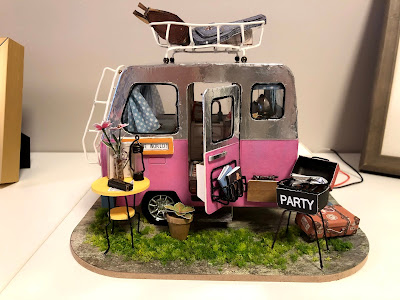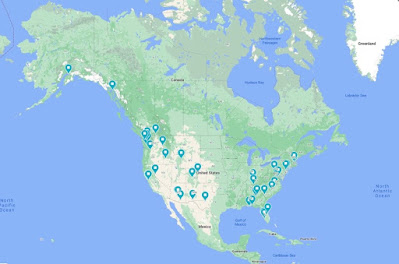For the past two months I have been dedicating a significant amount of time each week to figuring out where Cameron and I should live post-Poland. It's not as easy as simply saying "oh, I liked Missoula the time I was there for work and I always thought I would like Maine," although that is a part of it. I am quite meticulous about the process and I want to find the best option, and I do believe perfect can exist.
Now that I have narrowed our list of potential towns to live in to less than 50, I'm ready to share the first stages of the van plan process.
Step 1: What are our options?
I didn't want to neglect an opportunity, just because I hadn't heard of it before, so in addition to the list of towns and cities I already knew I was interested in, I asked for the recommendations of friends and family, took personality quizzes that resulted in the top places to live, and the "best places to live for ____" from various sources. I could have stopped there, but then I also researched the best places to visit and live state-by-state and and the top 50 towns and cities in the US and Canada. At this point I had an overwhelming 600+ cities, towns, and villages on the list. The next several steps were to narrow this massive number to less than 50.
Step 2: Livability Scores
For some of the places, I was jotting down notes on what to see while there or why it was an ideal spot, but for the most part I was still flying blind. I needed a way to make a massive cut, so I found a website that gave an overall livability scores and A-F rankings across various categories. For each place I marked down the livability score, any categories that the town scored an A in, and any categories that it scored a D or F in. Anything that scored less than 70 was nixed (bringing us to 371 places) and any towns with a D or F schools rating (brining us down to 302).
A cut of 50% is great, but 300 is still a huge number to work with. That 302 number could have been a little smaller but there are a few places that I kept on the list even when they didn't meet the standards everywhere else was held to. This was true throughout the process, so places like Bellingham, WA and Hood River, OR made it onto the final list even though they weren't perfect. Some of those originally saved places (like Juneau and Anchorage, AK) did ultimately get cut in further rounds of review.
Step 3: Population Density, Median Age, Male/Female Ratio
I found another website that gave each municipality's population, population density, median age, and male-to-female ratio, among other statistics that I didn't care about. It's not like I started this project thinking "I need a town that has a perfect 1:1 male:female ratio," but I figured if the information was easily available I may as well track it. I ended up removing anyplace with a ratio greater than 1.5:1 or less than 0.5:1, as well as towns with a median age greater than 50.
I figured that population density was more telling of how comfortable it would be for me to live somewhere than pure population count, but after compiling all of the data I realized I wasn't really sure what my ideal population density range was. I didn't end up cutting any places based on either population statistics, but the current top locations range from populations of 1,371,193 down to 1,282 and densities of 5,828 to 87 people per square mile. Surprisingly, the second largest city by population (Ottawa Ontario with a a population over 1 million) is the second least most densely populated (only 365 people per square mile).
Step 4: What airport options are available?
Figuring this out was a little tricky because just looking up "airports close to _____" ends up bringing up teeny tiny regional airports that only fly to 4 other teeny tiny towns in the surrounding counties. I ended up having to compile information from Google Maps and a flight booking service. Any place that was further than 60 miles from from an airport that could fly to El Paso, TX (with one layover or less) got nixed. This brought us down to 256 towns.
Step 5: Other City Demographics
At this point, 256 felt like way too much to still be dealing with and I was ready to start being a little more cut-throat about getting rid of spots on this list. Next I went through another series of categorical ratings with a little less willingness to keep ones who were missing the mark on the list. The next round of cuts were for towns that scored less than a B- on their crime rate or diversity scores, places with less than 20% of the population having a bachelors degree, a diversity rate greater than 20%, and median house costs greater than $700,000.
Step 6: Skiing Options
At this point, I was still sitting on over 100 towns, and the more towns there are the longer it takes to research the next criteria. These 136 remaining places were still very spread across the US with a surprising number in Illinois and Ohio. I was getting sick of seeing so many midwest and southern towns dominating the list so it was time to bring in the ringer- proximity to good skiing.
This, too, took layers of research involving Google Maps, looking up "best skiing near _______," ski area maps, and other resort-specific Googling. I ended up cutting towns that were over 100 miles away from a ski area, and that nearby ski area had to have a vertical drop of at least 500 feet and a ski summit greater than 1000 feet. I laughed when I saw the only option for Texans was to drive 600+ miles to Ski Apache, the small ski area in Ruidoso that I used to be an instructor at. No surprise, the big south eastern portion of the US got removed and our total town count dropped down to 74.
Step 7: Walking Scores
50 was the magic number, but still even this next round didn't quite get us there. I've gotten quite used to being able to walk to work and run all of my errands by foot, so tracking the walking scores was next. Once again, I relied on a website. Even though I was eager to get below 50, I still made some exceptions to the rule I set (towns must have a walking score of 30 or higher) so I was left with 62 remaining municipalities.
Step 8: Final Cuts
I wasn't sure what else I could do with this list of 62. Even though I was able to find the average temperature highs and lows, finding a consistent way to track average humidity highs was impossible. Although high humidity is a big no no for me, it will have to be something we figure out as we go.
Another qualifier I was thinking of was distance to usable water (lake, ocean, river, etc.), but after the hassle of figuring out skiing, it didn't seem worth the work. At this point, I had seen each of these places on a map several times and knew that each of them were surrounded by blue splotches, so anyways I figured even if I did put in the work, it wouldn't result in any further cuts.
Other considerations were for common natural disasters, local shopping options, annual town activities, quality of public transportation, variety of restaurants, quality of healthcare... just too many, and none that I cared that much about. Eventually, it was a simple as Cameron saying "I don't want to live in French-speaking Quebec," so the 20-ish towns within the province of Quebec were removed, bringing us down to 43. It was quite a relief, and I will add the list to the bottom of this post.
So what's next?
This list of potential places to live was just one of three. I also have lists for places we want so see for social reasons and for personal activity interests. I'm in the process of mapping those all out to see what makes sense to see along the way to seeing these 43 spots. In addition to developing a loose route and timeline, I also want to research where we can park the van, where we can use the toilet, our shower options, our clothes washing options, public internet hot-spots, etc.
Cameron is starting to dig into our van options a bit more and researching what interior set up options might be best. Today, he started to inform me that for the low low price of $600 we could have a collapsable hot tub that only takes three hours to heat up! This is after he told me he wants to consider buying a brand new custom designed four wheel drive Sprinter cargo van rather than buying a used one *major eye roll*. We won't really have to make that decision until we move to the US and are actually able to make the purchase, but until then my goal is to plan everything that can be planned ahead of time.







Loved this! Team WA + Crested Butte + Whitefish but there are a lot of good choices. I too enjoy this type of research! You could perhaps look at home ownership rates and see if you could find religious statistics to help further narrow. You might try to narrow by nearby mountain elevation. I know Wisconsin has a ski area for example but black diamonds there are like greens elsewhere from the looks of what I saw as a “major ski area”. Tips! Maybe get stricter on the education metric, too.
ReplyDelete